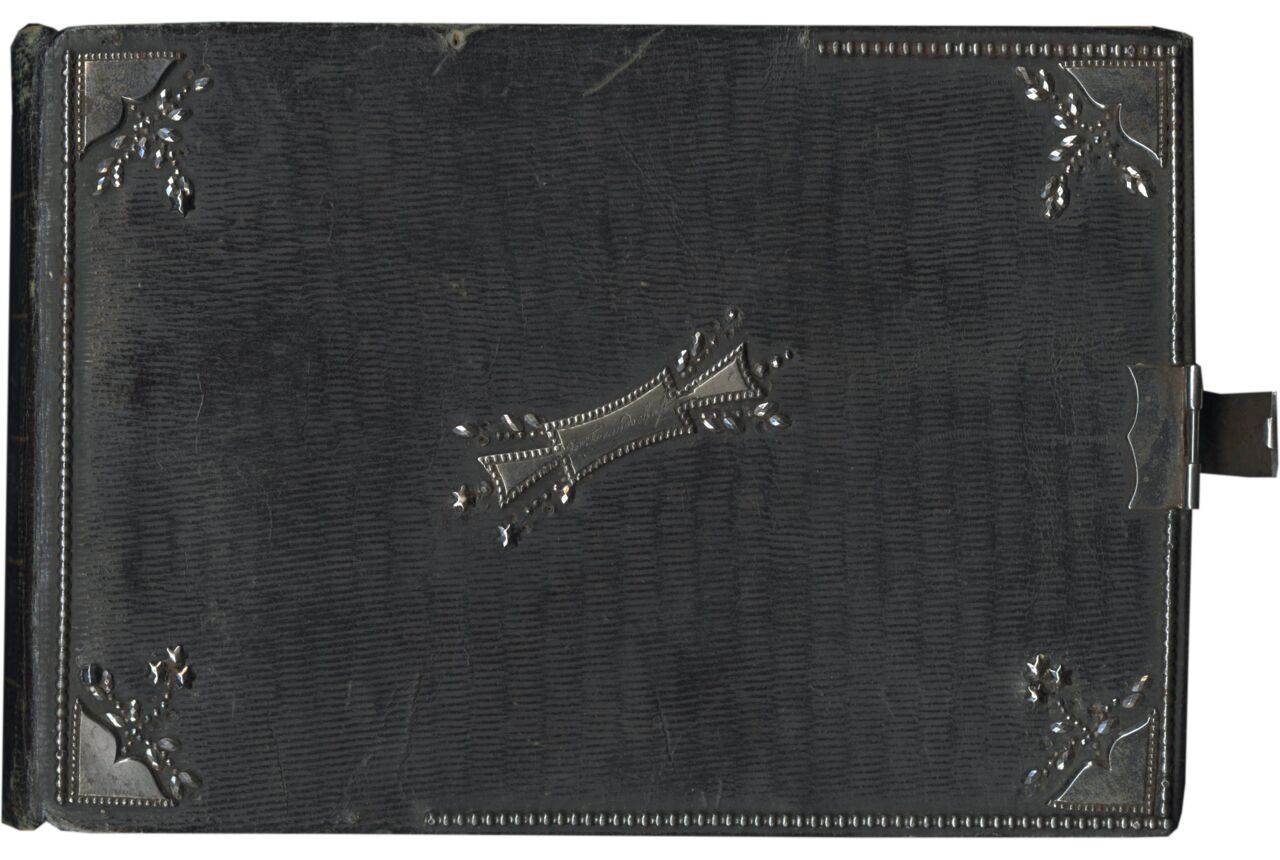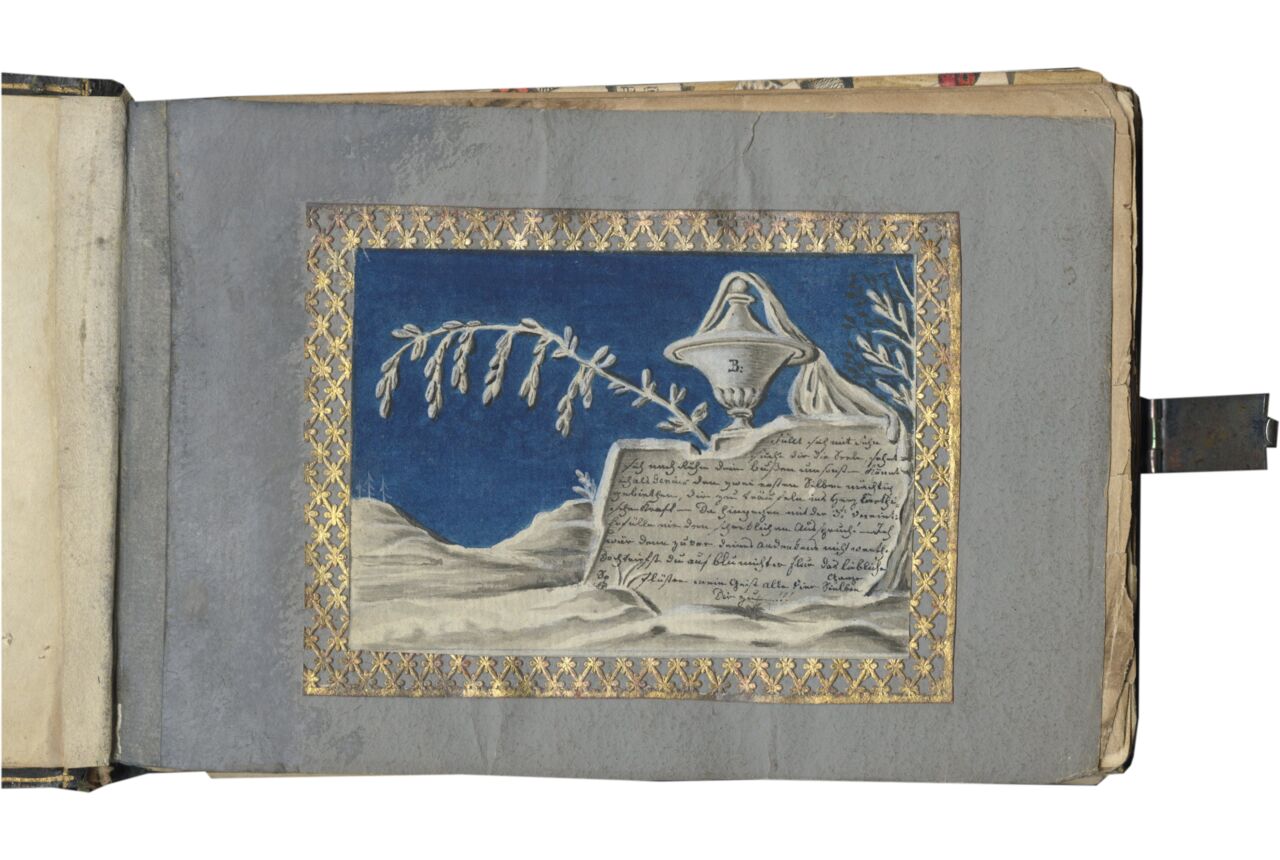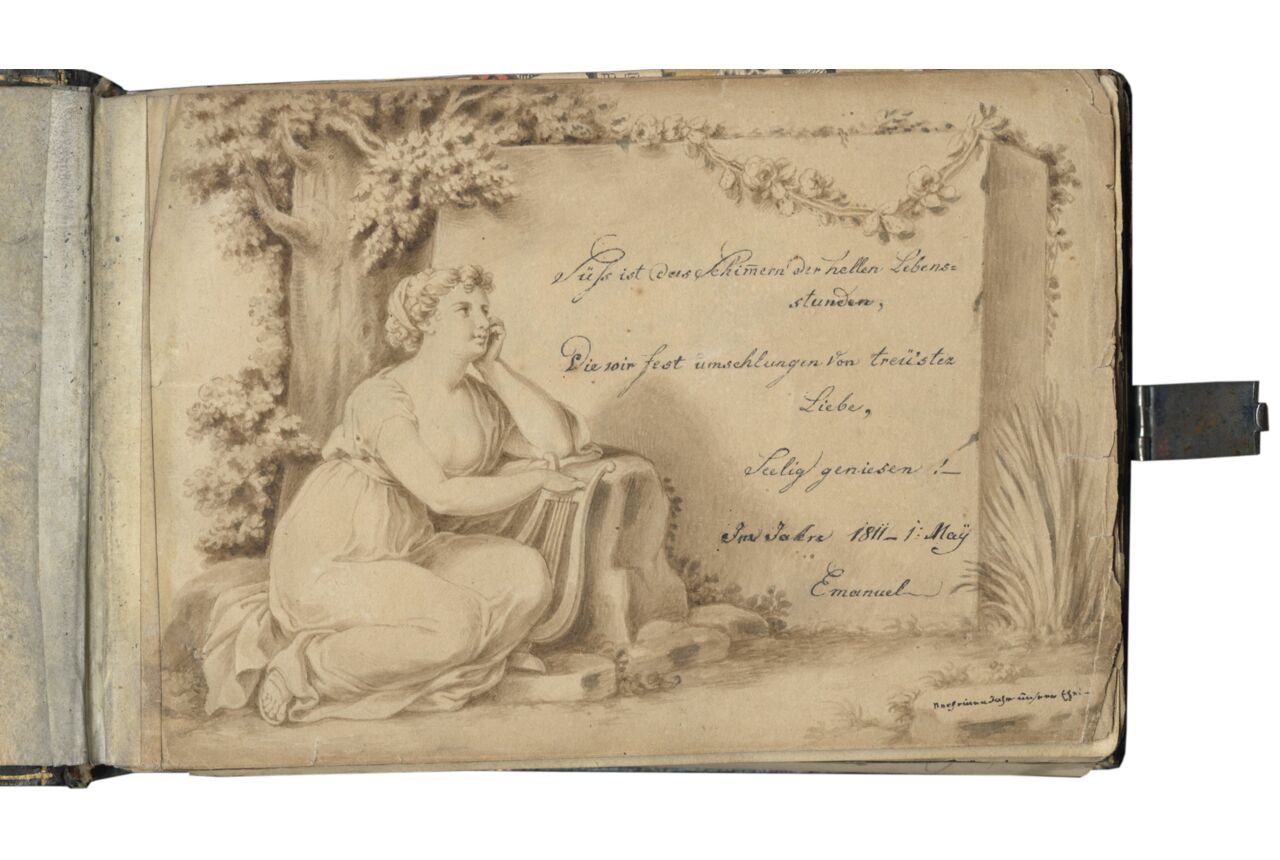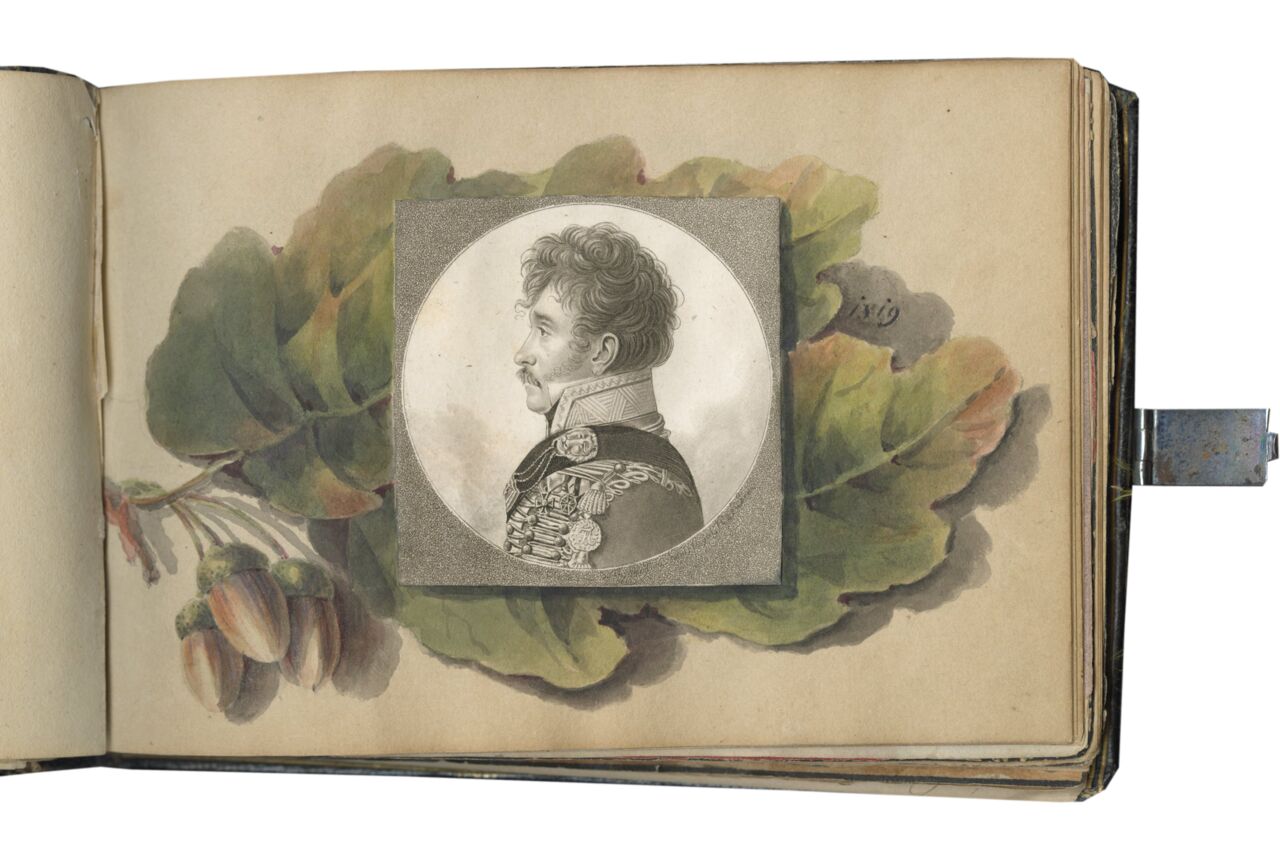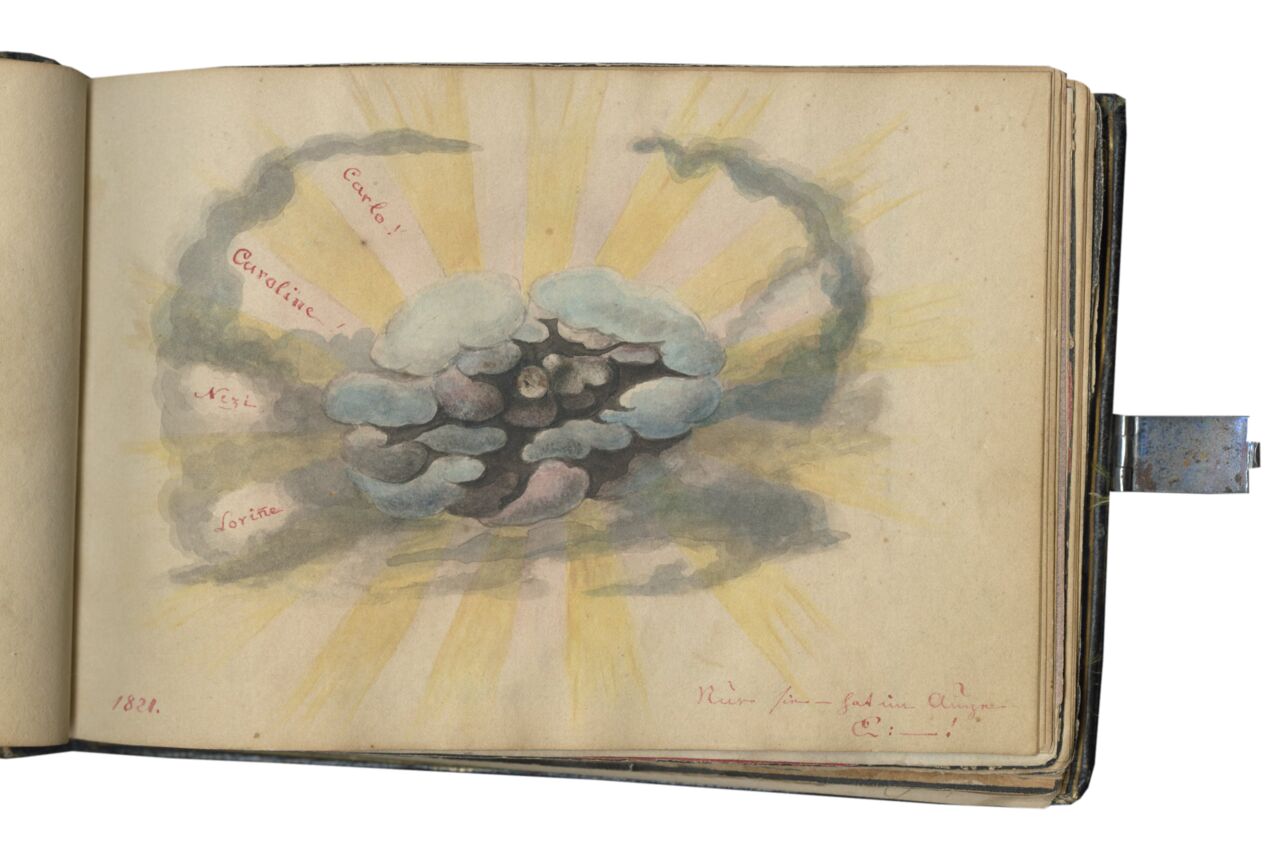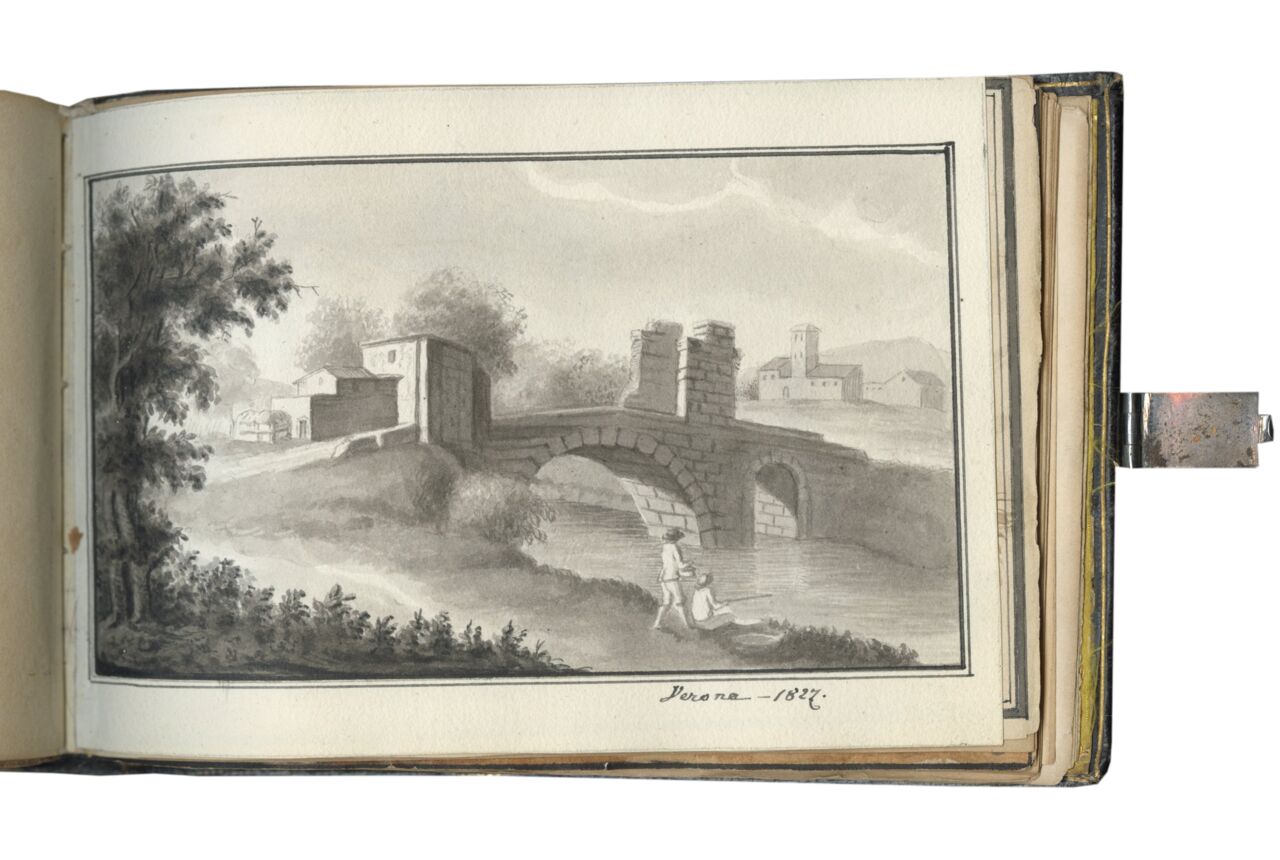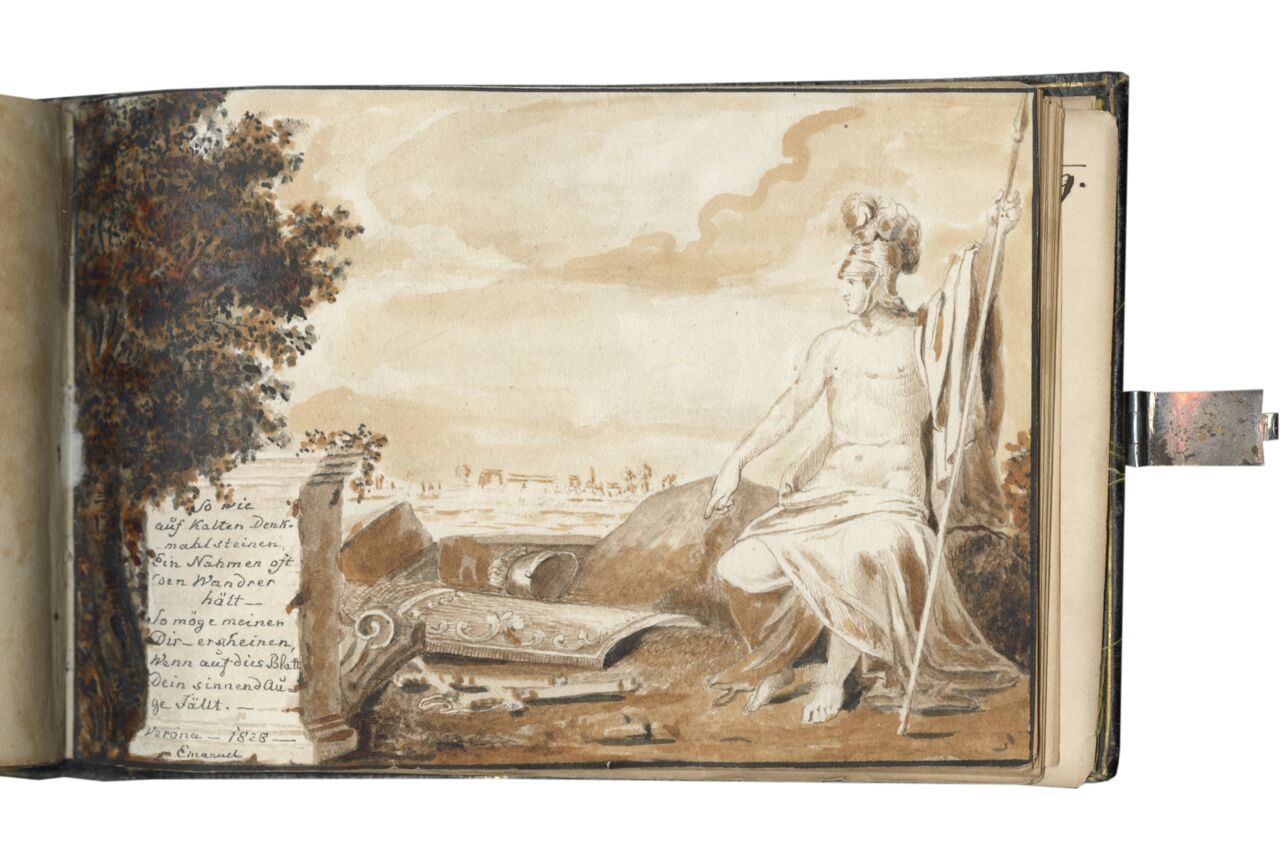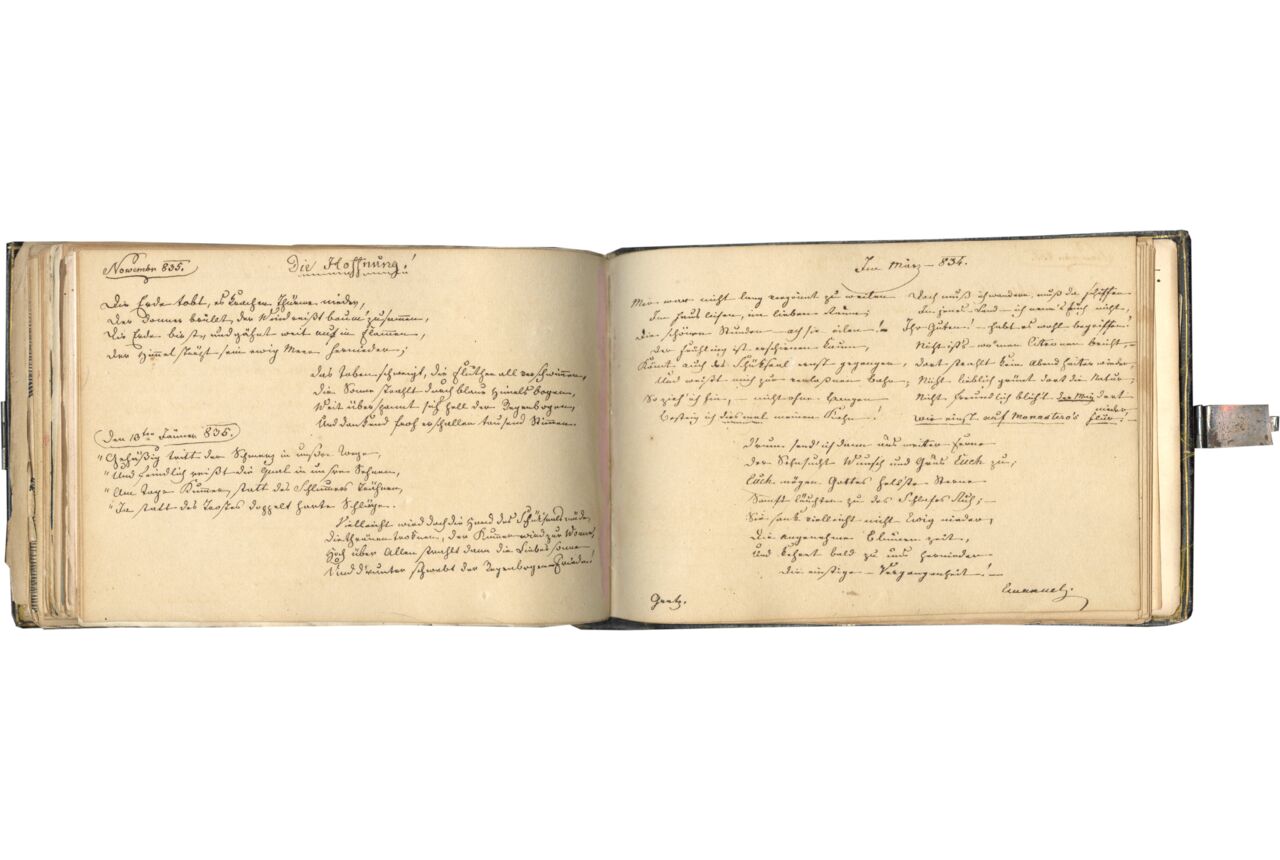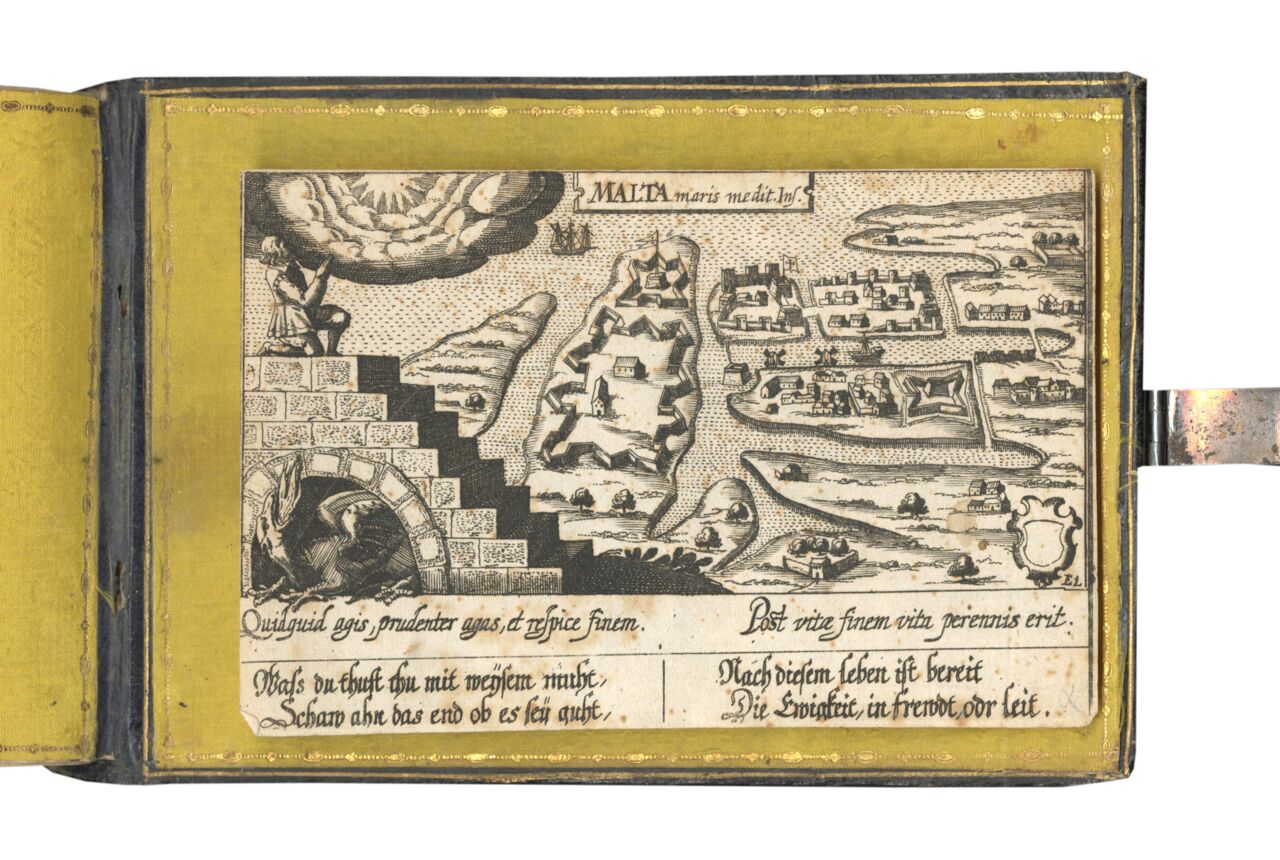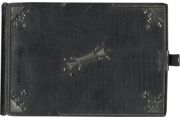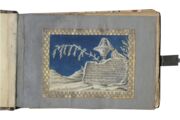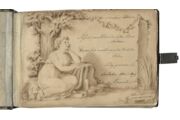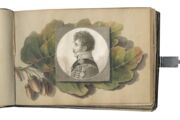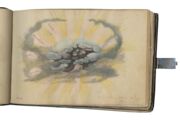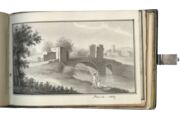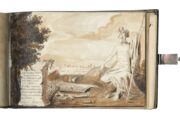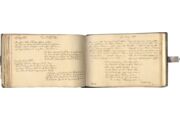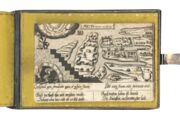i + 76 + i folios on paper, several watermarks including names of papermakers (not fully visible), modern foliation in pencil, 1-73 (including 31bis, 45bis, one unnumbered), lacking 3 silhouettes on f. 11 and 1 silhouette on f. 54, lacking a watercolor once pasted onto f. 45, some loose leaves kept within the volume, some loose leaves pasted onto pages, some original leaves excised (collation difficult), TWENTY-THREE WATERCOLORS, FIVE PEN-AND-INK DRAWINGS, TWO FULL-PAGE SILHOUETTES, ONE REBUS WITH MINIATURE SILHOUETTES ON TWO LEAVES, ONE HAIRLOCK ARRANGEMENT, ONE PRINTED ILLUSTRATION, SEVERAL PAGES WITH MICROGRAPHY, TWO MUSICAL SCORES, a tear in the inner margin of f. 6 without loss to the drawing, minor stains, some leaves have become loose from the binding, in overall very good condition. In its ORIGINAL BINDING of black morocco over pasteboards, flat spine gold-tooled with fillets, both covers with a frame of silver beads, silver corner pieces and center pieces with small leaves and stars, center piece engraved “Der Freundschaft / für Carolinen,” silver clasp and catch, pastedowns and endleaves in yellow silk with a gilt frame, gilt edges, kept in a modern cardboard slipcase, loss of some small parts of the silver furnishings on the covers (mainly on the frame on the front cover), slight wear of leather on the spine, otherwise in good condition. Dimensions 113 x 166 mm.
Long before social media, the Album Amicorum existed as a friendship book, passed around and carried about by its owner so that his or her friends and acquaintances could sign it, often adding pictures. What is highly unusual about the present Album Amicorum is that is an exchange only between a husband and wife. Every year without fail on his wife Caroline’s birthday, a nineteenth-century Bohemian general wrote poems or love letters and added paintings, drawings, and even music over their thirty years of marriage. In response Caroline sometimes added short notes or annotation.
Provenance
1.This friendship album was made in 1810-1840 by Baron Emanuel (“Manny”) von Bretfeld zu Kronenburg (1774-1840) for his wife, Caroline (“Lina”) von Bretfeld zu Kronenburg (1785-1842). All poems, letters, and artwork are by him.
The Bohemian military chief, Baron Emanuel von Bretfeld married Countess Maria Caroline Christine Wilhelmina, the daughter of Ferdinand Anton von Ahlefeldt, a Danish diplomat, and Princess Maria Theresa of Thurn and Taxis, the first female composer in Denmark, on May 1, 1810. He offered the manuscript to Caroline, as indicated by the engraved inscription on the silver centerpieces on the binding “Der Freundschaft / für Carolinen.” The entries start in the first year of their marriage and continue throughout their life together until Emanuel’s death in 1840. Several entries were made on Caroline’s birthday, January 16, and also on November 4, another important date the couple celebrated. Some entries were made directly into the book, others are on separate pieces of paper, sent from his travels, and pasted into the book, on birthdays and special occasions, to keep him close to her heart during his missions. There are short notes written into the book by Caroline on ff. 11, 54, 58, 62 and 63.
2. Belonged to N. F. Presse in 1915, whose ownership inscription in black ink, followed by the date “11. Jäner 1915” in German, is found inside the front cover. The inscription is made on a cut-out of a printed text pasted on the silk pastedown; the text concerns Emanuel Bretfeld and his family, and also mentions his daughter, Baroness Karoline Eleonore Freiin von Bretfeld, who was an opera singer.
3. Modern bookseller’s note “160” in pencil on the verso of the front flyleaf.
Text and Illustration
f. 1, Watercolor representing a snowy landscape with an irregularly cut slab of stone surmounted by an antique vase crowned with a swag of cloth; from the base of the vase extends a long branch; painted in gray tones against a deep blue sky; on the stone are eleven lines of micrography; the vase is inscribed “B:”; within a frame of pierced metallic-gold paper; pasted onto a page painted in gray-blue; [f. 1v, blank];
f. 2, Sepia painting in watercolor representing a Muse (Erato?) resting her hand on her lyre and gazing at the words inscribed on a stone: “Süss ist das Schimmern der hellen lebensstunden, Die wir fest umschlungen von treüster Liebe, Seelig geniesen!” (Sweet is the glimmer of the bright hours of life, which we enjoy blissfully, firmly embraced by loyal love!), dated and signed “Im Jahre 1811, 1 May / Emanuel”; [f. 2v, blank];
f. 3, Watercolor of a rose, signed in French by Emanuel “Manny le 13 de novembre 1810 à Warasdin” (Varaždin, Croatia); pasted onto the page on which is written a short poem; [f. 3v, blank];
f. 4, Grisaille pen and ink drawing with occasional blue wash representing an oval medallion with roses and other flowers, enclosing a poem in Italian: “Io te pur amano, Le fredde Ceneri, Nell urna ancora, Ti adorero!”; pasted onto the page; [f. 4v, blank];
f. 5, Watercolor representing a collection of personal papers affixed to a wall: letters (one dated 1812), maps, a watercolor of a landscape, a watercolor of oak leaves and acorns, watercolor of roses, a chessboard, wrapping paper, a calendar, musical scores, a playing card, a sealed envelope, a pen and ink drawing of a landscape; [f. 5v, blank];
f. 6, Grisaille painting in watercolor representing an angel projecting the new year “1812” onto a wall, while the old year “1811” is inscribed on a glass plate broken in half on the floor; an hourglass on the foreground refers to the passage of time; signed by Emanuel; the drawing was made directly onto the page of the book using a trompe l’oeil effect suggesting that it is on a separate paper pasted in; [f. 6v, blank];
f. 7, Watercolor representing a circular medallion framed by a snake biting its tail, enclosing a branch of an oak tree (symbol of loyalty); on the outer leaf is inscribed “Il ne change q’en mourant” (presumably referring to his enduring love); the first and second outer leaves form a flap-cover, behind which the name “Emanuel” is inscribed on a third leaf; background imitates wood; [ff. 7v-8, blank];
f. 8v, Printed calligraphic inscription: “Meiner Theuersten Lina von ihrem Manny zur Erinnerung Den 28 Marz 1813”; on a separate paper leaf pasted onto a tab;
f. 9, Grisaille painting in watercolor representing a medallion enclosing the title of the music that follows: “Romanze”, encompassed in a wreath and radiating light;
ff. 9v-10v, Musical score for a song with five verses; the staves are lines of micrography;
f. 11, Originally three black shadow silhouette portraits, now lacking, identified by Caroline as “Emo”, “Lorine” and “Theresa” (the first three children of Emanuel and Caroline, who at the time were 19, 25 and 26 years old) and dated “Ofen 16/5 1837” (cf. Ofen [Austria] marked on the map on f. 12); the exact forms of the portraits can still be appreciated due to the offsets from the black ink of the silhouettes; [f. 11v, blank];
f. 12, Watercolor and ink map of Austria-Hungary including stars and an itinerary in red, presumably marking places where he was stationed or passed through with his regiment; signed and dated 10 February 1819;
f. 12v, Poem dated “St. Helêne am 19 June 1817”;
f. 13, Letter in code: the letter “q” designates a different letter depending on the number of horizontal strokes (e.g. a = three strokes above and two across the descender), written for Caroline’s birthday 16 January 1818: “An Meine traute Lina zum 16 Jaenner 1818...”; [f. 13v, blank];
f. 14, Musical score, which can also be read turned upside down; the staves are made of lines of micrography; within a pen and ink frame dated “1815 / Emanuel”; [f. 14v, blank];
f. 15, Poem dated 1812; [f. 15v, blank];
f. 16, Poem for Caroline’s birthday, dated 16 January 1813 in Prague; f. 16v, a small inscription;
f. 17, Poem dated 1815 in Prague; [ff. 17v-18, blank];
f. 18v, Grisaille pen and ink drawing of the name “Carolina” in foliate letters, framed by roses;
f. 19, Short inscription dated 16 April 1815; [f. 19v, blank];
f. 20r-v, Poem, dated 10 June 1816;
f. 21 [loose leaf], Pen and ink drawing of three shepherds in a landscape; [f. 21v, blank];
f. 22, Grisaille painting in watercolor representing a country scene with a couple in a landscape; in the background, ruins of a castle on a cliff overhanging a lake; the man holds a scythe over his shoulder and the woman is seated on the ground; [f. 22v, blank];
f. 23, Grisaille painting in watercolor of oak leaves, over which is a pen and ink portrait of Emanuel in uniform; the trompe l’oeil shading cleverly suggests that the portrait is a separate piece of paper placed on the oak leaves; which symbolize Emanuel’s enduring love for his wife, dated 1819; [f. 23v, blank];
f. 24, Watercolor representing rays of sunlight shining behind a cluster of clouds; on the rays are written “Carlo!”, “Caroline”, “Nizi”, “Lorine”, dated 1821; [f. 24v, blank];
f. 25, Watercolor for Caroline’s birthday, pasted onto the page, representing a putto holding a book that is signed and dated by Emanuel, 16 January 1817; [f. 25v, blank];
f. 26, Watercolor representing two scenes: on the left, a bridge over a waterfall; on the right, a garden with a tempietto; within black watercolor frames, signed Emanuel and dated 1819; [f. 26v, blank];
f. 27, Letter from Emanuel to Caroline for her birthday written in code: the letter “q” designates a different letter depending on the number of horizontal strokes (a = one stroke above and four across the descender, cf. f. 13 with the same text); dated 16 January 1818; [ff. 27v-28, blank];
f. 28v, Printed poem “An Carolinen”, very small calligraphic type, dated 4 November 1818, printed on separate paper pasted onto a tab;
f. 29, Watercolor representing pansies (Fr. pensées [thoughts]), quills and a paintbrush resting on a letter, painted in trompe l’oeil; dated 1 May 1819; [f. 29v, blank];
f. 30, Poem dated 4 May 1819; [f. 30v, blank];
f. 31r-v, Poem, dated 20 June 1817 in St. Helêne, written on pink paper with a metallic frame, pasted onto the page;
f. 31bis v, Printed love letter for Caroline’s birthday, dated 16 January 1820, pasted onto the book;
f. 32, Calligraphic pen and ink drawing of a radiant sun made with micrography (the minute handwriting is hardly legible under magnifying glass); the text appears to be a prayer; [f. 32v, blank];
f. 33, Reserve lettering on black ground, ornamented with metallic paper, enclosing the birthday inscription: “An Lina den 16ten Jänner 1821 in Brandeis”; micrography in the arabesques; [f. 33v, blank];
f. 34, Green silk ties gathered together and pasted to the page, dated 23 September 1827 in Verona; [f. 34v, blank];
f. 35, Watercolor representing two branches of forget-me-nots united by locks of hair from Emanuel, Caroline and the two daughters Lorine and Theresa, sown into the image in bows (the text below identifies the locks: 1. Manny, 2. Lorine und Lina, 3. Theresa und Lina);
ff. 35v-36, 16-line rebus with 33 remarkable miniature silhouette images, dated 4 November 1821; [f. 36v, blank];
f. 37, Sepia painting in watercolor of a couple walking in a moon-lit landscape with a lake and a tempietto, pasted onto the book; [f. 37v, blank];
f. 38, Poem for Caroline’s birthday, dated 16 January 1822 in Brandeis; [f. 38v, blank];
f. 39, Watercolor and ink map “Meine Lebens-Reise bis 1822”, showing the towns Emanuel visited up until 1822 and the battles in which he had participated, marked with a small pair of crossed swords; painted with a trompe-l’oeil effect against black background; [ff. 39v-40, blank];
ff. 40v-41, f. 40v, Portrait of Caroline in grisaille painting (watercolor); on the facing page, f. 41, portrait of Emanuel in grisaille painting (watercolor); both in matching watercolor frames painted in trompe-l’oeil over piles of letters; Caroline depicted face-front, Emanuel in profile facing her; both pasted into the book; [f. 41v, blank];
f. 42, Poem, dated 1834; [ff. 42v-43, blank];
f. 43v, Full-page silhouette image representing a young man reading a book by a tempietto, pasted onto the page; [f. 44r-v, blank];
f. 45, Poem for Caroline’s birthday, dated 16 January 1825 Brandeis; [f. 45v, blank];
f. 45bis, Calligraphic pen and ink drawing on blue paper with a central medallion decorated with pen ornament and containing the inscription “Meiner theuersten Lina”, surrounded by rays and arabesque swirls; inside the medallion is written a poem in microscopic script, beginning “Wenn dir auch oft ob diesem Erdenthale...”; dated 4 November 1826; [f. 45bis v, blank];
f. 46, Poem; [f. 46v, blank];
f. 47, Watercolor of two daffodils for Caroline’s birthday on 16 January 1827, painted in trompe l’oeil on brown paper; the textures, light, shadows and the illusionistic effects of the water drops and the affixed note to Caroline once again demonstrate Emmanuel’s artistic talent; [f. 47v, blank];
f. 48, Poem; [f. 48v, blank];
f. 49, Poem, dated 4 November 1827 in Verona; [f. 49v, blank];
f. 50, Grisaille painting in watercolor of a landscape showing two men fishing by a river next to a bridge, dated “Verona 1827”; [f. 50v, blank];
f. 51, Sepia painting in watercolor of a landscape representing a tempietto on the right in the background; on the left in the foreground, antique ruins enclose a poem “Eintracht. Atribut der Liebe und des Friedens...”, dated “Verona 1828”; [f. 51v, blank];
f. 52, Poem, dated 4 November 1825 in Brandeis, written on pink paper, pasted in; [f. 52v, blank];
f. 53, Poem, dated 4 November 1832, written on light pink paper, kept loose within the volume; [f. 53v, blank];
f. 54, Originally black shadow silhouette portrait (now lacking) identified by Caroline as “Wilhelm Taxis” and dated “Ofen 16/5 1837” (cf. offset portraits on f. 11); the form of the portrait can still be appreciated due to the offset from the black ink of the silhouette; [f. 54v, blank];
f. 55, Sepia painting in watercolor of a landscape representing a Roman soldier seated on the right pointing at antique ruins; on the left, a pedestal bearing a poem “So wie auf Kalten Denkmahl steinen...” requesting that this page evoke Emmanuel’s name like that on a Roman memorial monument, dated Verona 1828; [f. 55v, blank];
f. 56, Poem dated 19 August 1832; a seal cut out from a letter dated 10 June 1836 is inserted here; [f. 56v, blank];
f. 57, Poem, dated November 1833; [f. 57v, blank];
f. 58, A small note by Caroline about Emanuel in Verona on 6 September 1827;
f. 58v, Poem entitled “Die Hoffnüng” (hope) dated November 1835;
f. 59, Poem, dated March 1834; [f. 59v, blank];
f. 60, “Winarsc...? 8 Mai 1827” (no other content) in the hand of ff. 11, 54, and 58;
f. 60v, Poem and offset of a flower that has fallen from the page;
f. 61, Poem, dated 9 April 1834;
f. 61v, Poem dated 30 October 1835;
f. 62, Originally a leaf from a tree pasted here (now lacking), with an inscription by Caroline in French: “feuille d’un arbre du Chateau Taxis sous lequel ma bonne Mère a souvent reposé dans son enfance et a jeunesse (?) eveillé, et envoyé par mon oncle Max mois de septembre 1827 à Prague”; [f. 62v, blank];
f. 63, Leaf from a tree, with an inscription by Caroline in French: “feuille d’un arbre pris de ... et mi pendant une Bataille le marechal Frimont sauva la vie à mon mari.”; [f. 63v, blank];
f. 64, Poem, dated 4 November 1834, written in pink ink; [f. 64v, blank];
f. 65, Grisaille painting in watercolor representing two birds, a staff, flower garland and quiver with arrows with the initials of Emanuel “E. B.”; [f. 65v, blank];
f. 66, Poem, dated 4 November 1836 in Ofen;
f. 66v, Poem for Christmas Day, dated 25 December 1837;
f. 67, Poem for Caroline’s birthday, dated 16 January 1837;
f. 67v, Poem, dated 4 November 1837 in Ofen;
f. 68, Poem “An meine Caroline!”, dated 4 November 1838 in Ofen;
f. 68v, Biographical notes written by Emanuel, dated 31 August 1836;
f. 69, Poem for Caroline’s birthday, dated 16 November 1839 in Ofen; [f. 69v, blank];
f. 70, Poem, dated 4 November 1839; [f. 70v, blank];
f. 71, Poem for Caroline’s birthday, dated 16 November 1840 in Ofen, [f. 71, blank];
f. 72, Poem “Ich bin (?) klein...”, dated 6 June 1827, perhaps written by one of the children, pasted onto a tab; [f. 72v, blank];
f. 73, Short note on 26 September 1827; [f. 73v, blank].
[unnumbered, kept loose within the volume], 1638 print by the poet Daniel Meisner representing the town of Valetta on Malta, inscribed at the top “Malta maris medit.inf.”; cut without the title above the image “Finis Vitae considerandiis est”; on the verso modern bookseller’s notes “XXV / 692”, “24402”.
Baron Emanuel von Bretfeld was born in Prague in 1774. He began his military service in 1789 at the age of 15 as a cadet of the hussar regiment of Count Wurmse and distinguished himself during the capture of Belgrade on October 8,1789, at the end of the Austro-Turkish war (1787-1789). In 1792 he earned distinction in the battle of Landau against the French, and in 1795 he participated in military operations in the Rhine Valley and in Italy. In 1809 he was promoted to major, in 1827 to major general, and in 1830 to field marshal lieutenant and divisional officer. As major in the regiment of Count Frimont he participated, amongst others, in battles at Pordenone, Savile, Olmo, Piave, San Daniele del Friuli, Raab (Kingdom of Hungary), Bassano, Caldiero, San Michele, and Monzambano. Caroline’s inscription on f. 63 informs that Frimont saved Emanuel’s life in a battle; Emanuel saved a leaf from the battlefield for Caroline as memorabilia (for Frimont, see Online resources).
Emanuel von Bretfeld is known for his successful military career, but our manuscript reveals him also as an accomplished amateur artist. The watercolors and pen and ink drawings are skillful, many with splendid trompe l’oeil effects. The two-page rebus with miniature silhouette images is especially impressive. The pen and ink drawing on f. 6 representing a magic lantern is also notable. Before the first overhead projection apparatus was invented in 1853, its predecessor, the magic lantern, was used to project images. It was developed in the seventeenth century and used a concave mirror behind a light source (see in our drawing the “chimney”-like structure, which contains a candle) to direct the light through a sheet of glass (the “slide”) into a lens at the front of the apparatus.
Typically, the album amicorum, or album of friends, was compiled by young aristocrats, who collected entries from their entire circle of friends, relatives, and acquaintances during their travels and studies. Our manuscript offers another important perspective to the study, as it records the friendship and love between only two people. Furthermore, the album amicorum was mainly popular among men, whereas our manuscript, adding greatly to its interest, was made for a woman.
The album amicorum is central in modern transdisciplinary research studying texts, reception, and collecting in cultural and social contexts and the history of mentalities; see especially the comprehensive study by Werner Wilhelm Schnabel published in 2003. The albums date from the sixteenth until the nineteenth century, and throughout their history, they usually assumed an elongated horizontal format, as is also the case for our manuscript.
Literature
Fechner, J.-U. (ed.). Stammbücher als kulturhistorische Quellen, Munich, 1981 (Wolfenbütteler Forschungen, 11).
Keil, R. and R. Die deutschen Stammbücher des sechzehnten bis neunzehnten Jahrhunderts. Ernst und Scherz, Weisheit und Schwank in Original-Mittheilungen zur deutschen Kultur-Geschichte, Berlin, 1893 (reprint Hildesheim, 1975).
Klose, W. “Stammbücher: eine kulturhistorische Betrachtung,” Bibliothek und Wissenschaft 16 (1982), pp. 41-67.
Kurras, L. Zu gutem Gedenken. Kulturhistorische Miniaturen aus Stammbüchern des Germanischen Nationalmuseums 1570-1770, Munich, 1987.
Lilienthal, M. Schediasma critico-literarium de philiothecis varioque earundum usu et abusu, vulgo von Stamm-Büchern, Königsberg, 1712; rev. Wittenberg, 1740 (repr. in Fechner, 1981, pp. 237-298). [the first study of Alba Amicorum].
Nickson, M.A.E. Early Autograph Albums in the British Museum, London, Trustees of the British Museum, 1970.
Rosenheim, M. The album amicorum, Oxford, 1910.
Schnabel, W. W. Das Stammbuch: Konstitution und Geschichte einer textsortenbezogenen Sammelform bis ins erste Drittel des 18. Jahrhunderts, Berlin, 2003.
Schünemann, H. “Stammbücher,” Schrifttumsberichte zur Genealogie und zu ihren Nachbargebieten 2 (1965), pp. 67-108.
Taegert, W. Edler Schatzholden Erinnerns: Bilder in Stammbüchern der Staatsbibliothek Bamberg aus vier Jahrhunderten, Bamberg, 1995.
Thomassen, K. (ed.). Alba amicorum. Vijf eeuwen vriendscap op papier gezet. Het album amicorum en het poëziealbum in de Nederlanden, Maarssen/The Hague, 1990.
Online Resources
Emanuel von Bretfeld zu Kronenburg (Wikipedia):
https://de.wikipedia.org/wiki/Emanuel_von_Bretfeld_zu_Kronenburg
Johann Maria Philipp Frimont, Count of Palota (Wikipedia); https://en.wikipedia.org/wiki/Johann_Maria_Philipp_Frimont
“RAA: Repertorium Alborum Amicorum” https://raa.gf-franken.de/de/startseite.html
Listing our manuscript, https://raa.gf-franken.de/de/suche-nach-stammbuechern.html?permaLink=1811_bretfeld
Suzanne Karr Schmidt, “Eighteenth-Century Social Networking,” October 20, 2021
https://www.newberry.org/18th-century-social-networking
TM 1246


